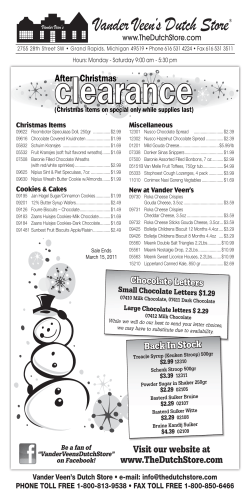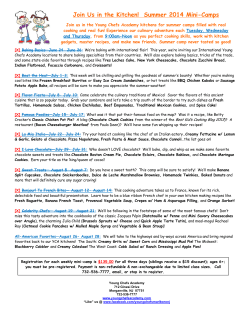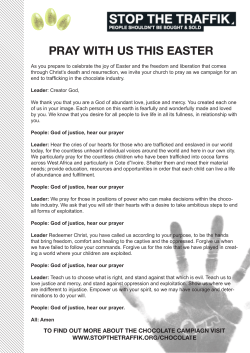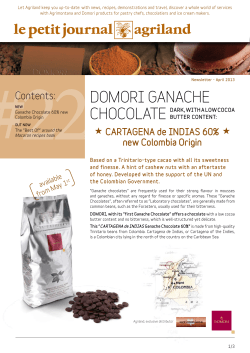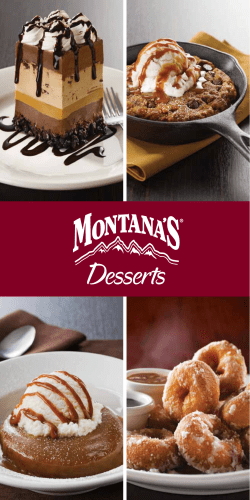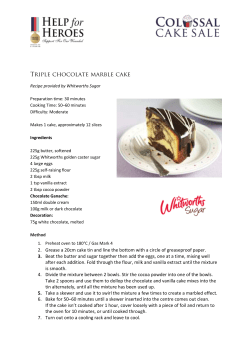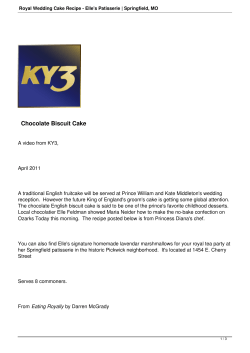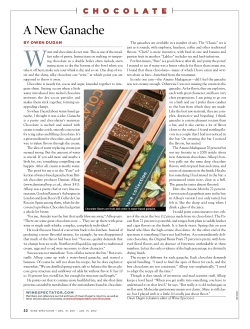
Boutique Chocolate Tasting & Pairing Guide
Boutique Chocolate Tasting & Pairing Guide Moonstruck Chocolate of Portland Oregon Est. 1993 History: Moonstruck Chocolate Company is a hand crafted artisan chocolate company based in Portland, Oregon. The company's award-winning truffles are sold primarily through select gourmet food retailers across the country, special order, and at the company's own Chocolate Cafes, where you can also find chocolate based beverages and desserts. Established in 1993, Moonstruck was founded on the premise that chocolate is not simply a candy, but an experience to be enjoyed by all the senses. Today, the company's delicately crafted truffles and other fine confections are inspired works that have been enjoyed in such prestigious locations such as the White House. Moonstruck chocolate products are made with only the finest, freshest ingredients. The company's chocolate originates from rare cocoa beans that are among the highest quality produced anywhere in the world. When properly fermented and roasted, the cocoa seeds achieve fine profiles of unique flavors with nuances of fresh flowers, ripe fruits and rich woods. Moonstruck artfully blends this exquisite chocolate with other natural ingredients found in the Pacific Northwest, including brandies and hazelnuts from Oregon's famous Willamette Valley. The result is a rare, world-class and truly special chocolate reflective of the Pacific Northwest character. Each morning our artisans are up early hand pouring, piping or rolling each and every truffle which is then hand decorated to perfection. Robert Hammond, our Chocolatier takes great pride in creating one-of-a-kind truffles that are beautiful, whimsical, and deliciously decadent. Website: www.moonstruckchocolate.com Custom Orders please contact: 800-557-MOON between 8 AM and 5 PM PCT Meet the Chocolates: Ocumarian: a rare and special Criollo cacao from the Ocumare valley of Venezuela brings a special flavor to this dark chocolate truffle with a hint of Ancho and Chipotle chilies Tuaca: Milk chocolate Ganache flavored with Italian Tuaca (butterscotch) liqueur and smooth honey vanilla caramel fill a milk chocolate shell Bailey's Irish Cream: Irish Cream liqueur flavors a milk chocolate Ganache coated with milk chocolate and garnished with 24 carat gold. What the press is saying about Moonstruck. -"I've got four words for you...Bailey's Irish Cream Truffle!" - O Magazine -"...viewers will find Moonstruck in Portland, Oregon, where they create some of the most elegant truffles in the Western Hemisphere" Food Finds - Food Network MarieBelle™ NYC Chocolate Est. 2000 For as long as she can remember, Maribel has been a food entrepreneur. "When I was just a child of eight, I made sugar candies and sold them to children in my neighborhood," explains presented by www.tastenetwork.org Maribel. From that enterprising beginning, Maribel moved to New York City where she studied fashion design at Parsons School of Design. Always on a voyage of discovery, Maribel's imagination sparked a business career that has included creating her own catering company, Maribel's Gourmet Cuisine; and MarieBelle™ Fine Treats and Chocolates, the brand's flagship retail space, has been open since 2002 in the heart of the SoHo neighborhood in downtown New York City. Thanks to eclectic, color-rich designs by accomplished New York artist and husband Jacques Lieberman, Maribel's chocolates are as delightful to behold as they are heavenly to taste. The brand's collection of signature chocolate ganaches each display a one-of-a-kind work of art that turn the simple act of eating chocolate into a full sensory experience. The MarieBelle experience starts with the brand's signature box of vivid blue and deep brown, which opens to reveal the visually stunning chocolates, as well as the heady aroma of the rich, pure chocolate, and then finally to the creamy, smooth taste of our over 25 different ganache flavors. They combine the finest chocolate eclectic ingredients, and artisanal techniques, creating nothing less than works of art. The chocolates resemble semi-precious jewels as displayed in their beautiful Italian boxes. Website: http://www.mariebelle.com Valentine Orders please contact: (866) 925-8800 ET Meet the Chocolates: Croquette au Chocolat (Light & Dark) - Delicate buttery European cookies provide the soothing texture and crunch at the heart of the new MarieBelle Croquette au Chocolat, a sublime and elegant milk chocolate bark presented in a MarieBelle antique-style box. Three individually wrapped delicious croquettes totalling one pound. The Ganaches - MarieBelle's luscious morsels are handmade with only the finest cocoa, freshest fruit essences and richest creams. Using up to 72% cacao beans, these high concentrations result in a rich, complex flavor not commonly found. Exotic flavors are continuously being added to the line; fans now choose from over 20 flavors, including Earl Grey Tea, Saffron, Spices, Cardamom, Lemon and Hazelnut. Today we are trying: The Blue: Cardamom The Pink: Cinnamon The Yellow Lady: Espresso Continuously devoted to beauty, quality and creativity, MarieBelle® Aztec Hot Chocolate was born. Maribel's own divinely decadent recipe contains NO COCOA POWDER but instead is made from the purest Belgian cocoa and most refined sugar. With 4 flavors (Aztec Original (63%), Aztec Dark (73%), Aztec Mocha and Aztec Spicy) and 4 recipes (Hot Chocolate, Ice Chocolate, Chocolate Pudding and our own personal favorite, Spicy Hot Chocolate Nightcap with Tequila) you can't go wrong. Temptation abounds...can you resist? Location: MarieBelle Fine Treats and Chocolates MarieBelle New York 484 Broome Street New York, NY 10013 (212) 925-6999 (866) 925-8800 L.A. Burdick Handmade Chocolates of New Hampshire Est. 1987 Over 18 years ago...Larry Burdick began making chocolates in New York City for a small number of fine restaurants and caterers, using a variety of European couverture that he learnt studying abroad. We hold to the same small-batch, hand-molded philosophy when it comes to making our gourmet bonbons and pastry, and running a French inspired restaurant as well as three cafés to showcase our chocolate. presented by www.tastenetwork.org In chocolate-making as in cooking, if you use the best ingredients to start with, you've won half the battle. We don't use extracts, concentrates or flavorings. Our complementing flavors come directly from their sources. We brew coffees and teas, cook fruits, squeeze and zest oranges and lemons. Herbs and spices are used as needed. No two batches of the same recipe are exactly the same. We use local honey, Mexican vanilla beans and a variety of nuts and dried fruits from California and Turkey; the best we can find! The fine alcohols we use are the same we pour for our friends and family at a good meal. Lastly, but not least of all, we use only butter and fresh local milk and cream to cook with, no other fats or oils are used! Larry Burdick - Larry grew up in Boston, spent the late 70s in France and the mid 80s in Switzerland. Larry has been cooking with chocolate and making chocolate confections since 1984 and established L.A. Burdick Chocolate in New York City in 1987. Michael Klug - Michael is the Chocolate & Pastry Chef at L.A. Burdick Chocolate. Michael is a native of Montabaur, Germany, a town between Frankfurt and Cologne. Joining the food business in 1986, he gained his experience as a Pastry Chef at Lespinasse, Chantrelle and The Mark, all in New York City. He joined L.A. Burdick in October 2002 where his focus continues on the flavors, textures and complexity of the confections he devises. Website: http://www.burdickchocolate.com Custom Orders please contact: 800.229.2419 Monday - Friday 8:30am - 5:30pm EST Meet the Chocolates: Orinoco - A blend of mostly dark Venezuelan chocolate with some milk Venezuelan chocolate. The chocolate has very elegant round flavor of high quality resulting from the Criollo based bean and the blend of dark and milk chocolates, Caribbean spices and rum. It is the most pure straight chocolate ganache filling flavor in the Burdick portfolio. It is decorated with crushed cocoa nibs which are the inner part of the roasted Cocoa bean Richelieu (cherry) - Chocolate bonbon with a filling of marinated dried cherries in Kirschwasser and accented with cumin seeds. Blended with hazelnut gianduja and high quality dark chocolate from France. Decorated with petite dried cherries and finished with white chocolate lines. Fig Truffle - A dark chocolate bonbon celebrated by figs marinated in dried port wine. The chocolate blend is Venezuelan bean based dark chocolate from France. The final piece is garnished with a port wine soaked golden raisin. The milk and dark chocolate interior balance the flavor of the fig and port wine. Ginger Truffle - Dark chocolate ganache (blend of Venezuelan, French and dark Swiss) chocolate with tiny bits of crystallized Australian ginger. Lemon Pepper Truffle - Dark Caribbean chocolate with a mix of lemon zest, cream, crushed peppercorns and rum. Finished in cocoa powder. Baton Framboise - Baton shaped dark chocolate ganache with a blend of raspberries, butter and Trinidad based chocolate. Balance of fruit, chocolate and acidity. Garnished with crushed Sicilian Pistachios. Champagne Truffle - Dark chocolate ganache made with world-class marc de Champagne eau de vie, butter and a mix of French and Swiss chocolates. Marc de Champagne is a distilled brandy like spirit that is made from crushed grapes. The marc is very common in Europe since its the by-product in the champagne industry. In Italy, marc is known as Grappa and are clear colored a tout high alcohol. While in the Champagne they are dark colored like that of brandy quality-like spirits. Very subtle and elegant every Champagne house usually produces one style of marc, but unfortunately they are very difficult to find in the United States. We are using Marc de Champagne from Drappier, but used also Perrier Jouet in the past. presented by www.tastenetwork.org BT MCElrath. Est. 1996 It all started in 1988 with peas and carrots and ice cubes. A beautiful innocent 19 year-old server caught the eye of the chef de cuisine at a country inn on the Mississippi River. So he tossed a few peas and carrots at her. Stunned, she retaliated with ice cubes. Duly impressed by her quick response and sure aim, the chef married her. And together, they started a thriving artisanal chocolate company in 1996. B.T. McElrath Chocolatier, established in 1996 in Minneapolis, Minnesota, is a wholesale manufacturer, specializing in chocolate truffles and an assortment of European-style chocolate confections. The company is owned and operated by Brian T. McElrath, his wife Christine Walthour, and Richard Shaeffer. Meet Brian: Meticulous Artisan Chocolatier, Visionary, (still impishly young and doesn't care about age; a Libra through and through, balance is his watchword in taste and in Life). A graduate of the California Culinary Academy, Brian worked fastidiously as a chef for 18 years at nationally recognized restaurants, bistros, hotels and clubs in the Midwest including the Nicollet Island Inn and Interlachen Country Club. Recognized on the Travel Channel as one of the foremost chocolatiers in the U.S., recipient of the Fancy Food Show award (the Oscars of the food world) for most outstanding new product and outstanding confection two years in a row, included on the Food Network's Best Of…Chocolate Makers, voted Best Chocolate in the Twin Cities four years in a row… the list goes on. Website: http://btmcelrath.com Custom Orders please contact: 612.331.8800 8 - 5 pm CT B.T. McElrath Chocolatier 2010 E. Hennepin Ave., #78 Minneapolis, MN 55413 Zinfandel Balsamic Truffle - Fruity red wine and a splash of aged balsamic have a natural affinity in this whimsical dark chocolate truffle fish. Toasted Almond Toffee - Traditional buttercrunch squares made with pure butter from local creameries, drenched in smooth Belgian milk chocolate, hand-sprinkled with chopped toasted almonds. Santander Truffles - A dark chocolate truffle made with a special single-origin cacao from Columbia. We call them Santander, named after the region in Columbia that the cocoa comes from. B.T. McElrath will be introducing these treats this spring 2006. Don't forget Valentines Day: Cherry Hearts - New for 2006. These luscious hearts have centers of black cherry ganache encased in layers of dark chocolate. Hand-decorated and all natural. Chocolove of Boulder Colorado Est. 1995 presented by www.tastenetwork.org Chocolove started as the classic entrepreneur story - a dream, a garage, extended credit card debt and loans from friends and family. With its visionary chocolatier, and a solid concept, Chocolove became, and continues to be, a pioneer in the chocolate industry. Timothy Moley is the founder, owner and chocolatier at Chocolove. A tall and slightly eccentric man, he reminds you a little of Willy Wonka. His laid-back attitude, wry grin, and lanky physique would never lead you to believe he is a man who lives and breathes chocolate, and has been consuming two chocolate bars, every day, for the past ten years. Seriously. It all began in a cocoa field in Indonesia… Timothy was chewing on some cocoa beans doing volunteer work for USAID, a government program that promotes agricultural and technical education in developing countries. He had been living abroad on and off for two years, visiting over 28 countries, developing his palate with spices, teas and wines. And, like most of us, he had always dreamed of being his own boss, dedicated to something he loved. The idea of a career in chocolate inspired him and an idea began to form - to create a premium chocolate bar, paired with the romance of love. When he returned to the States, he began his chocolate education and quickly discovered a few key facts about the U.S. chocolate market: the average consumer could tell the difference between cheap chocolate and premium chocolate and they preferred premium chocolate; the available premium chocolate bar choices were limited, expensive and intimidating; no U.S. company was indicating the cocoa content on their wrappers; and flavors were boring. Chocolove was born. The idea was simple - a selection of distinctly flavored chocolate bars made with all-natural ingredients and the classic techniques of Europe's finest chocolatiers. The package design would resemble a love letter sent from a distant land, and inside each wrapper - a classic romantic poem. For the past ten years, Chocolove has been quietly developing a loyal consumer following in natural and organic food stores around the country, including Whole Foods and Wild Oats. Website: http://www.chocolove.com Where to buy: http://www.chocolove.com/where_to_buy.htm Contact (303) 786-7888 - -- 1-888-Chocolove (246-2656) Chocolove Extra Strong Dark Chocolate Bar 77% Cocoa Content : Pairs well with full-body reds, especially ports. One of the strongest chocolates made for eating, crafted especially for the dedicated chocolate enthusiast. Extra cocoa butter is added to this artful blend of African and South American cocoa beans. Chocolove Strong Dark Chocolate Bar 70% Cocoa Content and pairs well with Medium-body reds. Strong, bittersweet chocolate with intense, well-rounded cocoa flavors from African cocoa beans and a touch of Caribbean. Chocolove Cherries & Almonds in Dark Chocolate Bar 55% Cocoa Content and pairs nicely with Light-bodied reds. The chewy, crunchy combination of cherries and almonds provides a delicious flavor contrast initially, then gradually blends with the rich, complex flavor of dark chocolate. Chocolove Raspberries in Dark Chocolate Bar 55% Cocoa Content and pairs perfectly with Sparkling reds and zinfandel. Smooth, semisweet chocolate melts in your mouth as crispy bits of raspberry burst with flavor. The initial contrast comes together in a harmonious union, finishing with a chocolate note and the essence of raspberry seeds. Boutique Chocolate Tasting Guide How to eat Chocolate… The complex sensation that we call flavor has two major components- taste, sensed by the tongue, and aroma, sensed in the nose. Texture, while not strictly speaking a component of flavor, influences the rate at which we sense flavor and generates its own palatal responses, coarse to smooth, for example, or hard to soft. The chemistry of taste and aroma of chocolate is incredibly complex. The initial perception of flavor develops as chocolate is chewed and then melts in the mouth. During the transition from the time the chocolate first lays on the tongue to the lingering aftertaste, various "flavor notes" will be sounded on the senses of the attentive chocolate lover. Think of describing a chocolate bar like describing a fine wine and use the basic wine technique Look, Smell, Taste, Finsih and Mouthfeel. Look - Note the color and appearance of the chocolate. It should have a shiny appearance and solid color throughout. A dry or flaky texture indicates a chocolate bar that has been poorly stored or tempered. Color hues will vary depending on the cocoa content or unique ingredients the bar may contain. Smell - Like wine, premium chocolate bars have unique aromas. Single origin bars may even offer some hints of the country or season where the cocoa beans were grown. Taste - Take your time and note the first impression, the overall taste and the aftertaste. A 70% dark chocolate bar may start with a tangy bitter flavor, then continue with a robust body as it melts on your tongue, and finish with a strong, lasting cocoa aftertaste. A 33% milk chocolate bar may open to soft caramel flavors that next hint of banana and finish with a lightly toasted marshmallow. Premium chocolate bars offer you a complexity of flavors that, like fine wine, will vary from season to season and according to ingredients, production and processing techniques. How Chocolate is Made… Chocolate (Theobroma cacao) is a tropical tree crop. Roughly 50% of the world's chocolate is grown in West Africa, 40% in South America, and the remainder in southeast Asia. Cacao is a tree with large green leaves. Pods containing cacao beans grow off the main trunk of the tree. The pods, which look like acorn squash, each contain 20-40 almond-sized cocoa beans. Pods are harvested twice a year. After the pods are cut open, the soft, wet, pulpy beans are scooped out, piled, and allowed to ferment. The beans are then cured and sun-dried. The characteristic chocolate flavor begins to develop during the curing and drying process. After curing and drying, the beans are winnowed, roasted, cracked open, sifted and winnowed again, and then ground fine. The heat generated during the roasting and grinding processes further develops the chocolate flavor. The heat created during the grinding process also melts the cocoa butter in the beans, so that the finely ground cocoa beans turn into a thick liquid called cocoa liquor. This hot cocoa bean liquor is the consistency of cold maple syrup. (Cocoa liquor contains no alcohol. It is called liquor simply because it is liquid during grinding when it is hot.) Sugar is added to the cocoa liquor and it is further ground on a set of large steel rollers, called a refiner. After refining, the chocolate is conched, a process of stirring, heating and aerating that takes several hours. Conching grinds the chocolate against itself, allowing the volatile acidic and bitter compounds contained in the unprocessed beans to evaporate. The process also gives the chocolate a smoother and finer consistency, and further develops the flavor. Finally, the liquid chocolate is carefully cooled in a process called tempering and then poured into molds and cooled further to form chocolate. Chocolate further explained… Chocolate is made from cocoa beans, the fruit of the tropical tree Theobroma cacao. After harvest, the cocoa beans are fermented, cured and dried. The characteristic chocolate flavors are developed by roasting the beans. After roasting, cocoa beans are cracked into cocoa bean pieces and then ground finely. The result is cocoa liquor, which is liquid above 86 F but solid at room temperature. Cocoa liquor can be pressed, and cocoa butter can be separated from cocoa powder. Cocoa content is the total percentage of the chocolate bar that is made from cocoa beans. Unsweetened baking chocolate is pure cocoa liquor, with a cocoa content of 100%. Cocoa content is declared on Chocolove chocolate bars to indicate the strength of the chocolate. The higher the cocoa content, the stronger the chocolate. Other variables also affect flavor significantly, such as the origin of the cocoa beans, type of roasting, and use of extra cocoa butter in the formula. Cocoa content is also an indicator of value. Cocoa beans are the most expensive ingredient in chocolate. Higher cocoa content chocolate is costlier to make than lower cocoa content chocolate. Complex bitter compounds called tannins are the source of the chocolate flavor. Like fine wine, a well-made dark chocolate high in cocoa content will continue to develop flavor and mellow with time if stored properly. Aging Chocolate…. Like red wine, well-made dark chocolate will develop smoother and fuller flavor with time. Even premium Belgian chocolate has sharpness when newly made. Within six months, the presented by www.tastenetwork.org sharpness softens, and over the next six months to two years, the flavor continues to become fuller and longer lasting. Proper storage is the key to developing the flavor. For long-term storage and improvement with aging, chocolate should be stored in an airtight container. The temperature should be kept at 65 F to 68 F if possible. Chocolate can be cellared with wine CHOCOLATE GLOSSARY Blending - Process that occurs after roasting and before grinding of cocoa beans. Crushed beans are blended, determining the chocolate's flavor. Bloom - fat bloom: The white cast sometimes appearing on the surface of the chocolate (cocoa butter), resulting from poor tempering or exposure of the chocolate to incorrect temperatures. While usually undesirable, the product is safe to eat. sugar bloom: When condensation forms on the surface of chocolate, it combines with sugars present to create a syrup. Large sugar crystals remain on the surface of the chocolate when the moisture then evaporates. Cacao - The cacao plant itself, as well as its raw, unprocessed product. Cacao Content - The amount of cacao in a particular chocolate. In general, the higher the cacao content, the more intense the chocolate flavor and the lower the amount of sugar present. Chocolate - Ground cocoa beans mixed with sugar and vanilla. dark chocolate: Chocolate that contains more than 50% cocoa content. Besides chocolate liquor, it often contains added cocoa butter, sugar, vanilla, and often lecithin. milk chocolate: Chocolate liquor to which dairy, sugar, vanilla and often lecithin have been added. Quality milk chocolate should contain a minimum of 30% chocolate liquor.white chocolate: Made from cocoa butter, dairy, sugar and vanilla (and often lecithin). It does not contain chocolate liquor, but must contain at least 33% cocao butter to be considered of good quality. Couverture - A term used to describe high-quality chocolate - quality determined by bean quality, particle size of ground bean and amount of cocoa butter. Most confectioners agree couverture should contain at least 32% cocoa butter. Chocolate Liquor - The finely ground nib, or meat, of the cacao bean - technically not yet chocolate. It's also referred to as unsweetened chocolate. It's referred to as Pâte de Cacao on European chocolate labels. Cocoa Beans - The source of all chocolate and cocoa. Cocoa beans are found in the pods of the cacao plant. Theobroma cacao, an evergreen, is typically grown within 20° of the equator. Descriptive Words and Flavors Acidic Aromatic Balanced Big Cocoa Butter - The naturally occuring fat in cacao beans, essential in the making of good chocolate. Bitter A bean contains approximately 50% cocoa butter. Bittersweet Bold Cocoa Powder - The powdery substance made by pulverizing and sifting Burst the "cake" that remains after cocoa butter is pressed from the chocolate Buttery liquor. Chewy Conching - The process in which heavy rollers or rotating blades plow Complex back and forth through the liquid chocolate, kneading it to smooth out Crisp its texture. The resulting friction and aeration provokes chemical changes Crunchy that develop and round out the liquid chocolate's flavor. The amount of Deep conching time is important. Delicate Enrobing- Pouring a thin coat of chocolate over something, such as a Dense ganache interior. Developed Earthy Fermentation - A natural process in which the cocoa bean, with the pulp from the cocoa pod, undergoes a process by which bacteria and temperature Elegant Essence modify the composition of the cocoa bean and yields the characteristic chocolate flavor. Forward Fragrant Fresh Fruity Full-bodied Gentle Graceful Grainy Harmonious Intense Light-bodied Lingering Medium-bodied Perfumed Pronounced Roasted Seductive Short Smooth Soft Spicy Strong Supple Sweet Tangy Tart Toasted Tropical Up-front Cranberry Banana Berries Burnt Toffee Butter Caramel Cherry Cocoa Jam Marshmallow Milk Mocha Nutty Orange Pepper Raspberry Rose Walnut Truffle Vanilla CHOCOLATE GLOSSARY cont. Finesse - The measurement of the average particle size of the cocoa solids in the chocolate. Finesse is expressed in ten-thousandths of an inch or in microns. presented by www.tastenetwork.org Ganache - A smooth, silky mixture of chocolate, and cream, milk, butter or a combination of the three. Gianduja A finely ground smooth mixture of nuts, chocolate and additional sugar. Traditionally, made with hazelnuts and almonds. Gianduja can also be flavored. Grinding - Mechanical process of pulverizing the roasted cocoa bean nib to a smooth liquid known as chocolate liquor. Interior - A technical term used for insides or centers of confections that are commonly enrobed with chocolate. Lecithin - A natural product derived from the soybean that helps control flow properties in chocolate by reducing viscosity. Nibs - Meat of the cacao bean - the fundamental item from which chocolate is made. These dark, rich bits remain when the shells detach from the beans after they have been roasted. Press Cake - Product that remains after most of the cocoa butter has been pressed from the chocolate liquor. Press cake is pulverized to make cocoa powder. Roasting - A cooking or heating process using dry heat that fully develops the chocolate flavor of cocoa beans, similar to roasting coffee. Tempering - A process of heating, cooling and reheating melted chocolate so that it will solidify in a stable crystal form. Proper tempering, when followed by proper cooling, provides shine and good eating properties. Theobroma Cacao - The botanical designation for cacao. The genus name, Theobroma, is derived from the ancient Greek words for "god" (Theo) and "food" (broma). Descriptive Words and Flavors Truffle - An irregularly shaped, often oval confection of ganache, coated with chocolate, and usually finished with a cocoa powder exterior. Its shape Acidic should mimick the black truffle. Aromatic Balanced Vanilla - The flavor derived from the cured pod of a tropical orchid. The Big pod is referred to as "vanilla bean". Bitter Bittersweet Bold Burst Buttery Chewy Complex Crisp Crunchy Deep Delicate Dense Developed Earthy Elegant Essence Forward Fragrant Fresh Fruity Full-bodied Gentle Graceful Grainy Harmonious Intense Light-bodied Lingering Medium-bodied Perfumed Pronounced Roasted Seductive Short Smooth Soft Spicy Strong Supple Sweet Tangy Tart Toasted Tropical Up-front Cranberry Banana Berries Burnt Toffee Butter Caramel Cherry Cocoa Jam Marshmallow Milk Mocha Nutty Orange Pepper Raspberry Rose Walnut Truffle Vanilla Bored Doe 2004 Merlot(48%), Cabernet Sauvignon (28%), Malbec(13%) and Petit Verdot (11%). Colour: Deep vibrant red Aroma: Dark fruit, tobacco and white pepper Palate: Dark fruit, black currents and loganberries. Firm acid with fruit-rich mid palate and good finish. This blend of noble varietals shows good, gentle oak integration and ripe deep fruit. The combination of grapes from different sites provides balance, and the wine has good tannin evolution and structure. Madame Chevre, an udderley gorgeous doe, bored but mischievous, serenely looks out over her neatly manicured vineyards. She reluctantly conforms to legislation and tradition, and only utilizes Merlot, Cabernet Sauvignon, Malbec and Petit Verdot in her seductive blend. This she does vintage after vintage. Bored with tradition and legislation, she now uses her charm and seductive wines to add spice to her life. Beware, you are about to become her latest conquest! The Cabernet Sauvignon and Merlot grapes are grown on both the Fairview estate in Paarl as well as our Houmoed farm in Stellenbosch. The Fairview merlot is planted on the lower slopes of the Paarl Mountain, in decomposed granite soils, and the Fairview cabernet on sandy soils. The Houmoed farm has shale soils. Petit Verdot and Malbec are grown in Agter Paarl The grapes are crushed and destalked. Bordeaux yeasts are used and fermentation takes place in stainless steel tanks, with daily pumpovers. The wine is pressed off, and malolactic fermentation is completed in tank. The wine is transferred to barrel, predominantly 2nd to 4th fill French oak barriques, and matured for 12 months. The wine is then blended, lightly filtered and bottled. Tomme de Savoie [France] - cow Tasting Notes: The pâte is pale yellow, nearly white and has small holes. It sticks to the palate and has odours of cave. Tomme de Savoie is often made with skim milk after the cream has been used to make butter. This is why Tommes are traditionally low in fat content (20-40 %). There are many varieties of Tommes, and they are often named after the village where they are produced. Tommes made in winter are from the milk of cows that are fed hay, very different from the Tommes made with the summer milk from cows that gaze in the high mountain pastures. The maturing process often takes several months, which gives the cheese a thick rind with a rustic appearance. It is grey in colour with patches of yellow or red moulding. The taste is soft and fruity, and occasionally one can detect a subtle flavour of grass. presented by www.tastenetwork.org The Wolftrap 2004 Merlot (47%), Grenache (14%), Malbec (14%), Syrah (12%), Ruby Cabernet (8%), Cabernet Sauvignon (4%), Cinsault (1%) 14.38 % /vol presented by www.tastenetwork.org Flavor Profile & Doggish Character: Ripe and spicy fruit flavours dominate this wild, aromatic red blend. It is rich, juicy and full with a generous texture. French oaking detail is obvious on the nose and palate and extends to the lengthy, elegant finish of this wine. WINEMAKERS COMMENTS: 2004 was the coolest vintage since 1997 which allowed us riper tannins and beautiful balance in the resulting wine. The Pinotage component has given way for a generous proportion of Merlot which enhances the richness of the wine. TASTING NOTES: Ripe and spicy fruit flavours dominate this wild, aromatic red blend. It is rich, juicy and full with a generous texture. French oaking detail is obvious on the nose and palate and extends to the lengthy, elegant finish of this wine. pairng thoughts: Piave [ Italy ] pasteurized cow The cheese has an intense, full-bodied flavor, reminiscent of Parmigiano Reggiano that intensifies with age and makes this cheese absolutely unique. One of the great, if little known, cheeses of northern Italy. Firm textured, nutty, full flavor, aged for nearly a year. The Piave cheese is named after the river Piave, whose source is found at Mount Peralba in Val Visdende, in the northernmost part of the province of Belluno, Italy. A winding course brings the river toward the bottom of the valley, until it reaches the plain at the foot of the prealpi venete mountains in the province of Treviso. Piave cheese is born from the cheese making traditions of the land surrounding the ancient river, in which the curd is cooked and the cheese is aged until it is hard. The area surrounding the river is also where the milk is collected to produce Piave. The cheese has an intense, full-bodied flavor that increases with age and makes this cheese absolutely unique. This Piave variety is Mezzano, which means it is aged between for six months. We also offer a Vecchia variety which is aged for one year. Here is another cheese made from cow's milk collected in two milkings, one of which is partially skimmed for cream. This one in particular is produced in the Piave valley between Belluno and Feltre, more specifically in a dairy cooperative known as the "Cooperativa Latte Brusche". It has notable similarities with the more well-known Montasio cheese, and likewise shares many of the same methods of workmanship. The interior is compact, easy to cut, has no eyeing, and is a pale straw-yellow colour. Salting is done in brine and it is ready in its freshest variety after two months of maturation. For the medium-aged variety six months are needed, and after ten months it is finally considered "stravecchio" or extra-old. With the passing of time, Piave cheese continues to harden and becomes an excellent cheese for grating, while even maintaining its substantially sweet and delicate taste which characterises it before ageing. It is manufactured in a cylindrical shape with a height of eight centimetres (three inches), a diameter of thirty-two centimetres (twelve and a half inches), and a weight of somewhere around six kilograms (13 pounds). Spice Route Pinotage 2003 Wine Makers Tasting Notes: The fruit was very small and concentrated in colour and flavour Dark ruby red with aromas of spicy red fruit, dried figs, banana and vanilla.The palate is full robust with fleshy fruit. presented by www.tastenetwork.org Highlighting the sweet fruit potential of this variety, which is complemented by the distinctively sweet vanilla tones of American oak barrels in which the wine was matured. A big, but approachable wine. Five centuries ago, the ancient mariners braved uncharted seas to round the Cape in search of exotic spices. Their nerve and dash inspire the Spice Route philosophy. The Spice Route has found its signature wine style in the warm rolling hills along the Cape West coast. Matching traditional practices in the vineyards with modern, minimalist approaches in the cellar, they produce exceptionally ripe and deep-flavoured wines. Pairing Notes: Cashel Blue Co. Tipperary Ireland Taste: Medium-flavoured blue with a melt in the mouth creaminess, this cheese is less salty than the majority of blues. When young the cheese is firm and relatively moist with a fresh and slightly sharp flavour. With ageing it develops a melt-in-themouth creaminess and a rounder, mellower flavour. Cashel Blue can be matured for up to six months. All milk used for the cheese is now pasteurised. The very best cheese is made from April to October when the cows are out to pasture, but Cashel Blue is still excellent throughout the year. Each cheese is 12cm in diameter, 12cm in height, weighs 1.5kg and has a fat content of 54%. Cashel Blue is excellent on the cheese-board and is a favourite for cooking since it melts smoothly and retains its depth of flavour. Some Key Facts: Cashel Blue was developed in 1984, it is Ireland's original artisinal blue (rouqefort details) Cashel Blue is the creation of Jane and Louis Grubb, a husband and wife team. Cashel Blue is made entirely by hand from whole un-homogenised cows milk. Cashel Blue is available worldwide from Farmers Markets to gourmet Food Halls and leading supermarket chains in the U.K and Ireland. History: As early as the 1950s the Grubb family were producing dairy based products (butter and potted cream) on their farm, Beechmount, in the heart of Co. Tipperary, Ireland. In 1978 Louis Grubb returned from working as an agricultural research worker in the west of Ireland to the farm where he was born and raised. Along with him came his wife, Jane, and their young daughter, Sarah. Louis established a commercial dairy farm at Beechmount, selling the milk to the local creamery. Farming soon became depressed, and the monotony of milking cows day in day out, encouraged Louis and Jane to look at ways of breaking from straight farming and to diversify Beechmount. Before meeting Louis, Jane had worked as a chef for several years and maintained a love of quality food. Therefore she suggested they look at the possibility of making cheese and, having researched various styles of cheese (and learning how to make them), Jane and Louis identified that there was a gap in the Irish market with relation to blue cheese. While Danish Blue sold well in Ireland, there was no native equivalent. Jane set about developing a blue cheese and, in 1984, two years after first looking at cheese as a way of diversifying the farm, Cashel Blue began. In 2001 Sarah, Louis and Jane's daughter returned to the family enterprise together with her husband Sergio Furno, following a time working for a French cheese-maker in the Alps and a wine maker in Piemonte. Sergio, originally of northern Italian origin, had met Sarah over exchanges of rice and cheese while in university in Wales. Following university they both worked in various angles of the wine industry in England, Ireland, France and Italy during which time they fine-tuned both their tasting skills and business acumen and nurtured their passion for food and wine in general. Fairview Beacon Block Shiraz 2004 Colour: Dark ruby red. Aroma: Black cherries dark fruit and cedar. Overtones of leather and cinnamon, with whiffs of white pepper and cloves. Palate: Bold, with firm acid and good oak integration. The wine is complex, with a good balance of fruit and tannin, showing good maturation potential. Cellaring: This wine will mature beautifully over five to seven years. presented by www.tastenetwork.org At 33º 44’ latitude 18º 48’ longitude, the surveyor general’s trigonometric Beacon 194 rises above a mound of Ancient metamorphic shale. Formally the bed of a primordial ocean, these shales were blasted into a mound by the heating actions of magma penetrating close to the earth’s surface. The Dreyer family has farmed in Paarl since 1705. Willie the present generation Dreyer farmer has a intimate knowledge of dry land farming. Unirrigated bush vines battle through large, flat, grey shale stone. The roots must claw their way deep beneath the rock in search of moisture and nutrients. Nature and the farmer work a double shift: the Glenrosa soils of Paarl encourage grape-bunches with tiny berries; the vines are pruned to bear a small crop. The joint result is a wine of considerable concentration and distinction. Unirrigated bush vines battle through large, flat, grey shale stone. The roots must claw their way deep beneath the rock in search of moisture and nutrients. Nature and the farmer work a double shift: the Glenrosa soils of Paarl encourage grape-bunches with tiny berries; the vines are pruned to bear a small crop. The joint result is a wine of considerable concentration and distinction. In the vineyard: This dry farmed vineyard was planted in 1995, using Shiraz clone SH9A, grafted onto rootstock R110. The deep Glenrosa soil type, retains soil moisture well, and ripens the crop early without stressing, during our long hot summers. Planted in a North Westerly facing rocky outcrop, the vines are pruned to a "bosstok" or bush vine. Depending on the growth, the vine is pruned to between 3 and 5 bearers per vine. Summer canopy management including a topping, which will reduce wind damage and green cropping at 80% veraison to ensure even ripening. The vineyard is regularly visited during the ripening period and tested by tasting, visual and analytical examination to determine exact picking date. Rouge River Blue - [ oregon ] cow The Rouge River Blue is naturally rinded. This aging process imparts flavors from the Rouge River Valley. These naturally occurring molds from our terrior impart flavors of wild ripened berries, hazelnuts and pear. To preserve this whell we wrap it in grape leaves from the applegate appellation. The grape leaves are soaked in Pear brandy and tied with raphia. The Rogue River Valley was a vastly different region when Tom Vella arrived from Sonoma, California. Small, diversified farms dotted the landscape as well as sprawling pear orchards. Seasonal employment in the logging industry and at lumber mills employed many, but there were few jobs available to tide a family over an unusually long winter. It was during the Depression of the 1930's that a small creamery opened in southern Oregon. The new business promised to create year round jobs and was a welcome addition to the area. Vella immediately started growing the business and employing as many people as possible. He was mindful that the faster he expanded, the more he could help small farms in the Rogue River Valley to survive during these dire times. The farmers were with him from the start, supplying ample milk to the cheese factory. During this time, the Southern Pacific Railroad was the principal avenue of commerce offering freight and passenger service from Los Angeles to Seattle. This transformed the Valley into the cultural center of southern Oregon. The Holly Theatre was built in Medford to accommodate theatrical and operatic troupes stopping in Medford on the way to and from San Francisco and Seattle. The Rogue River Valley and Rogue Creamery did better than expected in the 1930s during the Great Depression and were prosperous compared to the rest of the state. From 1940 to 1948 the Valley made significant contributions to the war effort. Fairview Jakkalsfontein Shiraz 2004 Lightly crushed in stainless steel fermenters, the grapes were allowed to start fermenting naturally before Rhône yeasts were introduced to complete the process. A week of post-fermentation maceration followed before the wine was transferred to barrel for malolactic and further maturation for 16 months. Periodic racking obviated the need f or filtration. This is an inky wine, with deep berry, spicy and meaty flavours underpinned by solid, smooth tannins, ensuring a potential bottle maturation period of up to 10 years. Wine Spectator 91 Points presented by www.tastenetwork.org The Swartland (Black Land) region of the Cape gets its name from the indigenous velt "Rhinoceros Velt" which has a natural dark shade. This region has been farmed since the early 1700, by free burghers, who were settled by the Dutch East India Company to provide supplies for the companies' ships sailing to the spice islands in the east. Wild animals often preyed on the burghers' sheep, and competed for food and water. This provided an excuse to defy the administrators of the Cape, and start wine production in this region. Jakkalsfontein is situated around a spring where to this day, the eerie evening calls of black-backed jackals can be heard. Old unirrigated bush vines produce bunches of Shiraz grapes with small berries. Jakkalsfontein is a firm wine with concentrated berry, spice and meaty flavours and a long finish. Wine Makers Tasting Notes: The Jakkalsfontein vineyard in the Swartland region (Malmesbury) was planted in 1997 (Shiraz clone SH9C, rootstock R99). Dry farmed, bushvines grow in deep weathered shale soils. These soils retain moisture well, which is much needed in the latter part of the hot dry summers normally experienced in the Swartland area. Good viticultural practices, crop thinning and bunch selection will ensure a well balanced, low yielding crop (4.57 ton/ha). This, combined with the unique terroir of the Swartland results in this deep flavoured wine, expressing warm climate Shiraz. Valdeon - Spanish Blue Cheese made from Cow & Goat Milk Valdeon is a blue cheese from Leon made in the Picos de Europa, just outside Asturias. Produced with cow's and goat milk, Valdeon is sought after because is is still characteristically wrapped in leaves and makes for an appealing display. Valdeon is a creamier, milder blue than DO Cabrales. It has an excellent sweetness and tang with a nice earthiness at the finish This Spanish blue cheese is often sold as Cabrales in the United States because its flavor is similar to that bold blue, but is slightly tamer. It, therefore, appeals to a wider range of palates. The cheese is made in the Castille-Leon region of the northwestern Spain and is wrapped in chestnut leaves before being sent to market. The cheese has a very intense blue flavor, but is not as yellowed or as biting as true Cabrales. THE CHOCOLATE BLOCK 2004 A blend of Grenache, Syrah, Cinsault, Cabernet Sauvignon and a hint of Viognier. ALCOHOL: 14.84% presented by www.tastenetwork.org TASTING NOTES: Hints of bitter dark chocolate and spicy aromatics drive the nose of this wine. It has depth, mid-palate richness and sexy ripe tannins. While the Syrah and Grenache Noir offer the fruit and aromatics for this wine, the Cabernet Sauvignon offers structural components, the Viognier perfume and the Cinsault a juicy, ripe profile. WINEMAKERS COMMENTS: The 3rd vintage of this premium blended wine comprises of 124 barrique in total in the following proportion: Syrah 55 barrique, Grenache Noir 31 barrique, Cabernet Sauvignon 21 barrique, Cinsault 14 barrique, and Viognier 3 barrique. As before the Cabernet Sauvignon and Syrah were from a Malmesburyvineyard, the Grenache Noir from Citrusdal, the Cinsault from Wellington and for the first time the Viognier component came from the vineyards at Boekenhoutskloof. All fermented separately with all of the Grenache Noir being blended with a proportion of Syrah before maturation. This is due to the high oxidation potential of the cultivar. After alcoholic fermentation, malolactic fermentation was completed spontaneously in a combination of new and used French oak casks. All barrique were left on the primary lees for 15 months, an egg-white fining followed by a coarse filtration led to bottling in July 2005. Pairing Notes: BEENLEIGH BLUE from Neal's Yard [ united kingdom ] - Blue Sheeps Milk Cheese The flavour is sweet and fudgy. Blueing can get strong and spicy. more information: http://www.nealsyarddairy.co.uk/ We opened on July 4th 1979 in Neal's Yard in Covent Garden. At the time, Neal's Yard Dairy was owned by Nicholas Saunders, who had already started a bakery and wholefoods warehouse in the yard and Monmouth Coffee Company on Monmouth Street. Randolph Hodgson, had started work at the Dairy a couple of months earlier, helping with the initial set up. He helped research recipes and, after the Dairy opened, made greek-style yoghurts and fresh cheeses. After the first year, he had agreed to take over as the owner of the business. At first, the Dairy only sold products they had made on the premises. In Randolph 's words: "We didn't really know what we were doing and so we gave the customers a taste of everything and asked them what they thought". He realised early on that his customers' opinions were very valuable, and would help him improve his recipes. After a year, the Dairy started to buy matured cheeses too. At first these came from a wholesaler and were difficult to sell. It was very different from selling something they'd made and knew all about. One day, a cheesemaker called Hilary Charnley sent a sample of Devon Garland to the Dairy. Intrigued and interested to talk to another cheesemaker, Randolph set off to visit her. She was able to direct him to other farms in the area who also made cheese, and, by the time Randolph returned to London , he had filled the car with cheese to sell in the shop. Fired with enthusiasm and information from the cheesemakers themselves, Randolph found these cheeses much easier to sell. He made more visits to other parts of the country, met more cheesemakers and started to sell more types of cheese.
© Copyright 2025
